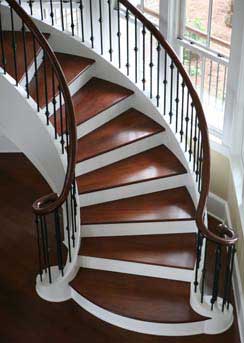Wood Stairs » Product Information » Stair Treads
Stair Treads have been the topic of two of our customers’ questions this week alone so we thought it would be a good idea to address this major stair component. Both customers asked whether or not they could use their hardwood flooring on their stairway as treads, which is a question we are commonly asked.
The short answer to this is yes you can. To elaborate though, you will find that most often although you can, if you want a long lasting product, you should not. Hardwood flooring, whether solid or laminate, is manufactured in relatively narrow boards that are then fitted side by side and end to end to cover a floor surface. The surface itself, whether concrete or plywood provides a solid foundation over a large area. In the case of stairs, flooring is used cover the rough, plywood treads but with an overhang called a nosing. This nosing extends beyond the rough riser, finish riser, moulding and further to create a bullnose detail. This is where most of the problems come from. In addition stairs have far greater movement than floors by their very nature so using a many pieced flooring tread as oppose to a “single” piece Stair Tread creates numerous issues.
Typical hardwood flooring is manufactured to achieve the least waste possible. Therefore while a certain percentage of a specific wood species is available in wider dimension lumber in order for the flooring to match up all pieces are all milled to the narrower width. The same is true for length, because the flooring will be fitted end to end, length is not an important factor so shorter pieces are perfectly acceptable for flooring. When used on stair treads, narrow and short flooring create a number of issues. First, there are many visible joints. This is not a problem on the floor where there is enough space to achieve a wide and varied patter. In the limited space of a tread, the joints are too small to be eliminated but too big to not look “pieced together” so even beautiful hardwoods don’t display at their best. The second issue is that because of the many joints the tread, and especially its leading edge, is significantly weakened and over time often begins to separate, move or break. The third issue is squeaky stairs. The squeaking sound some stairs make is caused by the movement of wood against wood. This can be in the framing, plywood or the finished treads or Tread Caps. The more joints you have the more likely your stairs will squeak. Thus the likelihood is greatly increase with the flooring method.
 Actual Stair Treads on the other hand offer several advantages. First, the lumber used will span the entire width of the stair without end joints. This reduces the likelihood of movement and squeaking. The lack of joints is stronger, more durable and looks better, not to mention the cleaning advantages when there are no “cracks”. The larger width of lumber that is used also provides fewer pieces. These are combined and manufactured into a single stair tread instead of the individual pieces of flooring. Again, the fewer joints both in width and length, makes the treads stronger and more durable. Finally, the nosing itself is not an added piece as in the case of flooring but part of the tread itself. This means that not only are Solid Treads more visibly attractive but there is not a joint at the worst possible place, where the nosing overhangs and is constantly under pressure and stress.
Actual Stair Treads on the other hand offer several advantages. First, the lumber used will span the entire width of the stair without end joints. This reduces the likelihood of movement and squeaking. The lack of joints is stronger, more durable and looks better, not to mention the cleaning advantages when there are no “cracks”. The larger width of lumber that is used also provides fewer pieces. These are combined and manufactured into a single stair tread instead of the individual pieces of flooring. Again, the fewer joints both in width and length, makes the treads stronger and more durable. Finally, the nosing itself is not an added piece as in the case of flooring but part of the tread itself. This means that not only are Solid Treads more visibly attractive but there is not a joint at the worst possible place, where the nosing overhangs and is constantly under pressure and stress.
So, while you can use hardwood flooring to piece together stair treads, the overwhelming benefits of solid stair treads cannot be overstated. To be fair, if price is your ultimate concern, flooring can be cheaper, especially in the case of laminates. However, when comparing apples to apples, solid hardwood flooring to solid hardwood treads, the prices are comparable while the advantages are not.
